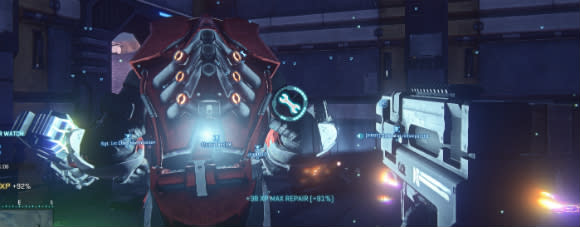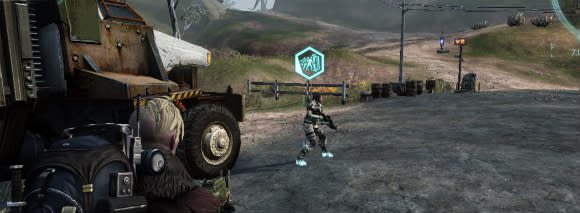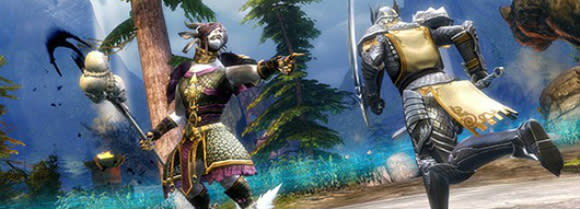Sixteen games that ease the MMO level gap -- and how they do it
There's nothing I hate more than logging into an MMO, running across a friend, and being hit by the wall of levels that separates us. She might act as if she's OK hanging out with a newbie, but the truth is that she'd rather be off doing high-level things with her high-level buddies. If only there were a way for us to jump into combat (or anything else) together from the get-go!
In many MMOs, that level gap is not an issue. There are a lot of creative ways to get around the problem, and some MMOs meet players more than halfway. Of course, there are a lot of MMOs that force players into a level-encased tunnel of grind, but today we want to shine some light on some of the ways MMOs help salve the level gap sting.

The easiest way to bridge the level gap is to flat out avoid having a level gap in the first place. In a game like PlanetSide 2, a new player can jump in along with his more experienced or veteran friends and be almost as effective as they are. Heck, it's possible that the newbie could be more effective than the veteran thanks to personal skill level, internet connection, or sheer PC power. Lag might do more damage than lack of experience in many cases. Defiance works in much the same way, basing combat more on where someone is pointing the crosshairs than how long she has been playing the game.
There are variables, of course. Even in a sandbox world like Wurm Online or in a shooter like PlanetSide 2, there are ways to "level." PlanetSide 2 has certification points that are earned as a player fights and spends time in the game. Those points unlock new weapons and add-ons. In Wurm Online, players gain levels in specific skills that might give them an advantage over other players in many ways.
The point is that in games that do not completely rely on levels -- like an MMOFPS -- a new player is not "locked out" from content just because she is new. Sure, the new player might be killed more than her more experienced buddy, but at least she'll be able to play without being left behind! In Ryzom, for example, a new player can have access to a healing spell that will actually resurrect a senior groupmate. It might take several minutes, but I've seen newbie healers make all the difference in the world after a high-level player sacrificed himself so that the newbie got to safety. Both levels helped each other.

Social MMOs are not really "games," at least according to the most rabid fans. A social world like Second Life provides no way to "win," so levels do not come into play. There or IMVU are other popular social MMOs that concentrate more on allowing players to get in and meet each other than anything else. Again, though, there is always something to gain by playing the game longer. There actually has skill levels for specific game-related skills like hoverboarding, and Second Life is absolutely filled with player-created games with levels, health, and other RPG trappings. These are optional pursuits, however. Social MMOs are great for meeting new people, exploration, and taking a break from leveling, grinding, raiding, and killing non-stop. Just watch out for drama... it can be more dangerous than any raid boss.
There are also MMOs that allow higher-level players to "step down" to a friend's level in order go on adventures together. City of Heroes was one of the first MMOs to really perfect the "sidekick" option. Its system fit within the comic genre perfectly and allowed veteran players to help out lower-level friends without sacrificing much. EverQuest II and RIFT call their versions "mentoring"; they also give higher-levels players the chance to step all the way down to a lower level. Guild Wars 2 steps your character's level down as you enter into a map, so running around as a nuisance, kill-stealing everyone's fun, is not part of the equation. Better yet, experience and rewards are still good for your true level.

RIFT makes mentoring particularly easy. Right-click on your portrait and step down to any desired level that is at least five levels beneath your own. You can also click on a friend's portrait and match her level. If you are on an instant adventure, you will automatically be leveled to match each other, making for a convenient way to earn experience without going through a lot of trouble. Mentoring in RIFT gives you experience that is equivalent to what you would get while playing as a high-level character. It's a simple solution to the problem of missing content.
Player-vs.-player combat is one of those delicate areas of an MMO where players truly do not want to be bothered with level gaps. Many players want a fair fight, and so more than a few MMOs have dealt with the issue head-on, even when they are not shooters or sandboxes. Following in the footsteps of classic Guild Wars, Guild Wars 2 automatically gives you a max level 80 character with full gear and traits after a short tutorial. Jump into PvP and you'll find enemies who could be as new as you. In World vs. World -- massive battles between potentially hundreds of players from three different servers -- health and damage are bolstered so that newer players are not victims of a single shot. Levels and gear in WvW do help out, though.

Star Wars: The Old Republic uses a "bolster" system in PvP, and all players move into combat at level 55. Even equipment is bolstered, empty slots being filled with simple level 55 items. Lord of the Rings Online calls PvP Monster Play. Upon reaching level 10, you can go to a social center and pick from a list of monsters that you are allowed to control on the battlefield. If you are level 80, you can fight as a member of the free peoples, taking the role of Hobbits and others while defending ruins, towns, and castles. It's a somewhat controversial -- if not unique -- approach to the level gap issue.
Of course, there are MMOs that have plenty of leveling to do but also offer so many variable, non-combat activities that there is something for everyone to do together. Mabinogi is called the fantasy life MMO because it has almost everything you might find in real life. Housing, crafting, adventuring, roleplay, and even fashion are intricate systems that encourage players to do something other than fight. RuneScape is known as a grinder's paradise, but the decade-old browser-based, sandpark often releases quests and events that do not require any level at all in order to participate. The game recently hosted a world-wide event in which players decided to fight or gather materials to help out one of two opposing factions. At the end of a designated time period, the "winning" side got to watch how its members' actions impacted the world. Any player of any level could help out.
And don't forget roleplay, exploration and socializing, three things that set MMOs apart from other genres and that are generally available to any player from any experience level in an MMO. There are lots of MMOs that either eschew levels altogether or that host systems that let people from all levels to play together -- these are just sixteen. Add more to our list in the comments!


